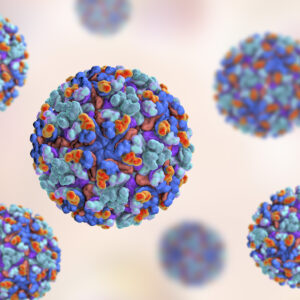Ross River Virus
Ross River fever (RRF) is a mosquito-borne infectious disease caused by infection with the Ross River virus. The illness is typically characterised by an influenza-like illness and polyarthritis. Symptoms of the disease vary widely in severity but include arthralgia, arthritis, fever, and rash. About a third of infections are asymptomatic, particularly in children. The first outbreak of RRF was in 1928 in the Hay and Narrandera region in New South Wales, Australia. The virus was first isolated in 1959 from a mosquito trapped along the Ross River in Townsville, Queensland. Since then, outbreaks have occurred in all Australian states, including Tasmania, and metropolitan areas.
Ross River Virus Background
Ross River fever (RRF), also known as epidemic polyarthritis, is an illness caused by infection with the Ross River virus, which is related to another mosquito-borne virus, Barmah Forest virus. Ross River virus belongs to the virus genus Alphavirus (family Togaviridae), a group of small enveloped single-strand positive-sense RNA viruses. The disease is spread by the bite of an infected mosquito and occurs widely in Australia (particularly in northern and central Queensland) and Tasmania, the island of New Guinea, Fiji, Samoa, the Cook Islands, New Caledonia and several other islands in the South Pacific. Native animals such as wallabies and kangaroos are thought to be the main animals involved in the cycle of infection.
Ross River virus causes inflammation and pain in multiple joints (epidemic polyarthritis). The symptoms may include fever with joint pain and swelling which may then be followed in one to ten days by a raised red rash affecting mainly the trunk and limbs. The rash usually lasts for one to ten days and may or may not be accompanied by a fever. The joint pain can be severe and usually lasts two to six weeks. Some people, especially children, may become infected without showing any symptoms. Most people become unwell within three to 11 days after being bitten by an infectious mosquito.
Ross River virus infection cannot be spread from human to human. It is spread from animals to humans by a number of different types of mosquitoes with Culex annulirostris, Aedes vigilax (salt marsh mosquito) and Aedes notoscriptus being most common. Aedes vigilax breeds in salty pools in mangroves and salt marshes after flooding by spring tides and heavy rains. Culex annulirostris breeds in permanent bodies of fresh water while Aedes notoscriptus breeds in containers close to homes and other human activity.
The largest outbreak occurred in 1979–1980 in the Western Pacific, and affected more than 60,000 people. There is no specific antiviral treatment for Ross River virus and no vaccine to prevent infection. However, most people recover completely from these viruses, although recovery can take up to a few months.
References
- Ross River virus. 2019 Northern Territory Government of Australia.
Ross River Virus Antigens
The Native Antigen Company has manufactured a recombinant Ross River Virus antigen in mammalian cells, comprising the virus structural polyprotein. There is no specific antiviral treatment or vaccine available for Ross River fever at present and so this antigen has been designed to facilitate the discovery of new diagnostics without the requirement for live virus.
Ross River Virus Antibodies
The Native Antigen Company is pleased to offer a monoclonal antibody specific for Ross River Virus E2 envelope glycoprotein and suitable for R&D and immunoassay development.
Questions?
Check out our FAQ section for answers to the most frequently asked questions about our website and company.


